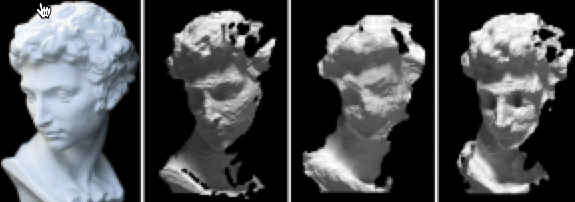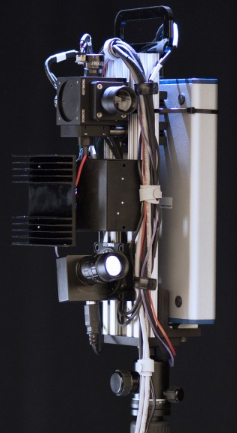A fast, high-quality, inexpensive 3-D camera
April 26, 2015
Northwestern University engineers have developed a 3-D capture camera that produces high-quality images and works in all environments, including outdoors, overcoming limitations of Microsoft’s Kinect. It’s also designed to be inexpensive.
The research is headed by Oliver Cossairt, assistant professor of electrical engineering and computer science at Northwestern’s McCormick School of Engineering,
Both first and second generation Kinect devices work by projecting light patterns that are then sensed and processed to estimate scene depth at each pixel on the sensor. Although these techniques work quickly, they are less precise than expensive single-point scanners, which use a laser to scan points across an entire scene or object.
Cossairt’s camera, named Motion Contrast 3D Laser Scanner (MC3D), uses single-point scanning in a different way. Modeled after the human eye, it only scans parts of the scenes that have changed, making it much faster and higher quality.
The Kinect does not work well outside because the sunlight overpowers its projected light patterns. The laser on Cossairt’s camera, however, can be sensed in the presence of the sun because it is much brighter than ambient light.
Cossairt believes his camera has many applications for devices in science and industry that rely on capturing the 3-D shapes of scenes “in the wild,” such as in robotics, bioinformatics, augmented reality, and manufacturing automation.
It could potentially also be used for navigation purposes and can be installed on anything from a car to a motorized wheelchair.

Capture-quality comparisons at 128×128 resolution (left to righ): Original image, commercial laser scanner (28.5 seconds), Kinect (1 second), and MC3D (1 second) (credit: Nathan Matsuda et al.)
The research, supported by the Office of Naval Research and the U.S. Department of Energy, was presented on April 24 at the IEEE International Conference on Computational Photography and is described in an open-access paper.
Cossairt’s group has received a Google Faculty Research Award to integrate their 3-D scanning technology onto an autonomous vehicle platform. Their scanner will provide high-quality 3-D scans in real time with only a fraction of the power of competing technologies, the Cossairt’s team says.
Northwestern University | Watch a demonstration of how the Motion Contrast 3-D Scanning camera works
Northwestern University | Motion Contrast 3D Scanning
Abstract of MC3D: Motion Contrast 3D Scanning
Structured light 3D scanning systems are fundamentally constrained by limited sensor bandwidth and light source power, hindering their performance in real-world applications where depth information is essential, such as industrial automation, autonomous transportation, robotic surgery, and entertainment. We present a novel structured light technique called Motion Contrast 3D scanning (MC3D) that maximizes bandwidth and light source power to avoid performance trade-offs. The technique utilizes motion contrast cameras that sense temporal gradients asynchronously, i.e., independently for each pixel, a property that minimizes redundant sampling. This allows laser scanning resolution with single-shot speed, even in the presence of strong ambient illumination, significant inter-reflections, and highly reflective surfaces. The proposed approach will allow 3D vision systems to be deployed in challenging and hitherto inaccessible real-world scenarios requiring high performance using limited power and bandwidth.
